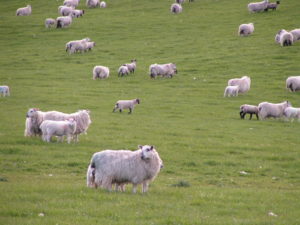Pre-Mating Management Of The Flock
23 August 2017 Weaning typically falls between week 12 and 16 of lactation; wean earlier if ewes and lambs are competing for scarce grass, wean later when grass is abundant.
Weaning typically falls between week 12 and 16 of lactation; wean earlier if ewes and lambs are competing for scarce grass, wean later when grass is abundant.
At weaning, go through the ewes and identify culls on udders teeth and feet. Do not cull based on ewe condition – the milkiest ewes may be the thinnest. Sell fat cull ewes immediately. Put the rest on best quality grass to regain condition for sale – they can be put in with the finishing lambs. Condition score the remaining ewes, the target at mating is condition score (BCS) 3-3.5 for lowland ewes and 2.5 for hill ewes.
Fat Ewes
Ewes over BCS 3 can be fed to maintain their condition – provide them with 4 cm average quality grass. They are worm tolerant so graze them on dirty pastures if required.
Thin Ewes
Ewes at BCS 2.5 and under need to gain over one condition score before mating. This equates to approximately 10 kg of liveweight gain for a 75 kg ewe; over eight weeks they will need to grow 150 – 200 g/day. These ewes are the top priority – they should be grazed on the best quality pasture and allocated an extra 1 kg of grass dry matter per day than the rest of the flock. They will only eat enough if their feet and teeth are sound. The target sward height is 6 – 8 cm. Red clover (up to 45 days before tupping), chicory and/or plantain are great for this job. Those under BCS 2 can be dosed if required.
Two Tooths
Two tooths that lambed as ewe lambs will often scan 20% lower than the rest of the flock. This is because they have had the stress of having to rear a lamb whilst growing. The target weight at mating is 80% of mature weight. Therefore, prioritise their feeding from weaning to reach this target.
Rams
It takes 8 weeks for sperm to mature, therefore sort through the rams now. Sort head, wounds, feet etc. A vet inspection of commercial rams is a sound idea but semen test by electro-ejaculation is not recommended for commercial rams. Many faults (e.g. missing soft testicles) can be picked up by inspection, this is best done close to breeding season. Scrotal circumference at mating is a good indicator of male fertility; the widest point on mature rams should be 34 – 36 cm for small breeds and 36 – 38 cm for large breeds.
Rams that have not been pushed hard with concentrates can serve 80 – 100 ewes and should live for five seasons. This results in a ram cost per lamb of under £1. On-farm sales and auctions, NZ based rams (e.g. Easyrams /Innovis /Wairere) may be a good starting point. Select based on EBVs for growth and carcass characteristics, as this type of Terminal sire ram will be small at purchase. Use in multi-sire mating groups with target of 3 rams per group. Mate two tooths/ewe lambs separately at 40 ewes/ram using mature rams that seek out first breeders.
John Vipond
Sign up to the FAS newsletter
Receive updates on news, events and publications from Scotland’s Farm Advisory Service
